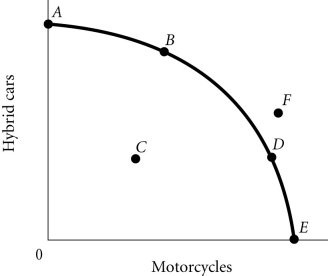Refer to the information provided in Figure 2.4 below to answer the question(s) that follow. Figure 2.4Refer to Figure 2.4. The economy moves from Point A to Point D. This could be explained by
Figure 2.4Refer to Figure 2.4. The economy moves from Point A to Point D. This could be explained by
A. an increase in economic growth.
B. a change in society's preferences for motorcycles versus hybrid cars.
C. a reduction in unemployment.
D. an improvement in technology.
Answer: B
You might also like to view...
Cassie's Quilts alters, reconstructs, and restores heirloom quilts. Cassie has just spent $800 purchasing, cleaning, and reconstructing an antique quilt which she expects to sell for $1,500 once she is finished
After having spent $800, Cassie discovers that she would need some special period fabric that would cost her $200 in material and time in order to complete the task. Alternatively, she can sell the quilt "as is" now for $900. What is her marginal benefit if she sells the quilt "as is" now? A) $100 B) $900 C) She makes a marginal loss of $600, not a marginal benefit. D) The marginal benefit cannot be determined.
If Holly's demand for fast food decreases as her income rises, then
a. fast food is a normal good for her b. the law of demand must apply c. fast food is a complementary good d. fast food is an inferior good for her e. fast food is a substitute good
Refer to the normal-form game of advertising shown below.Firm AFirm B??AdvertiseDo Not Advertise?Advertise$0,$0$175,$10?Do Not Advertise$10,$175$125,$125Suppose there is a 90 percent chance that the advertising game depicted in Figure 10-17 will end next period. The collusive agreement {(not advertise, not advertise)} is:
A. sustainable since $11.11 > $50. B. sustainable since $175 < $138.89. C. unsustainable since $11.11 > $50. D. unsustainable since $175 < $138.89.
A supply schedule
A) can be used to generate a supply curve. B) is a table reflecting the inverse relationship between price and quantity supplied. C) shows what happens to quantity supplied when price is held constant. D) all of the above.